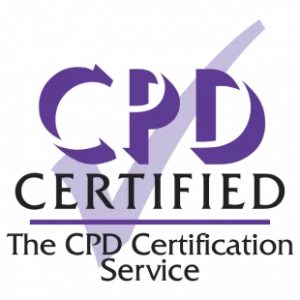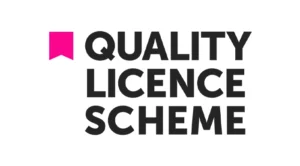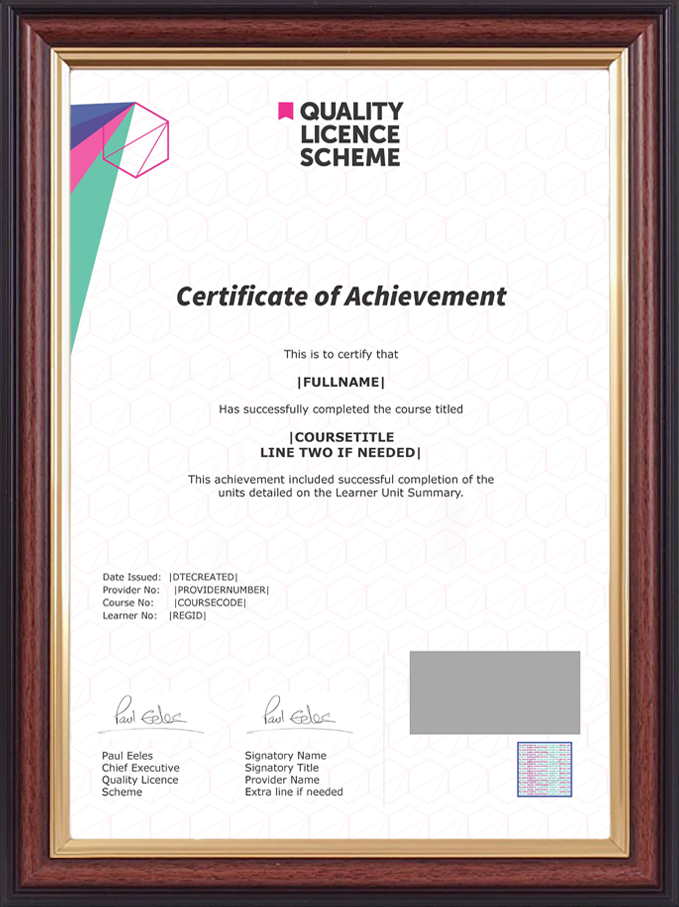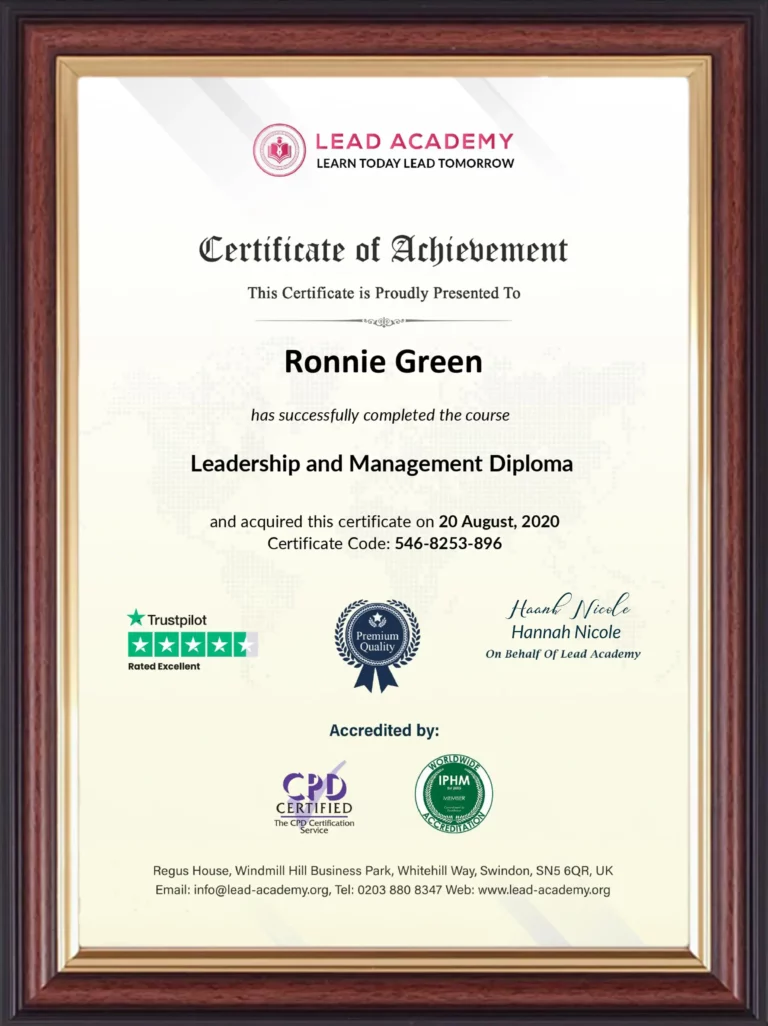
Self-Paced Online Learning
Learn on your own accord, wherever you want, whenever you want.
4 Instalment Plan on checkout
You have the option to choose from four easy instalment plans.
14 Days Money Back Guarantee
Hassle-free guarantee on purchase, ensuring quality & your peace of mind.
Course Fee
£29
£125
 77% OFF
77% OFF
👉 CPD UK Accredited PDF Certificate Included
![]() 4 interest-free payments of £7.25
4 interest-free payments of £7.25


Enrolling in this course will prepare you to assess and mitigate risks and manage crises efficiently. With this course, you will be empowered with identifying potential threats, implementing measures and effectively managing crisis situations.
This Course At A Glance
- Accredited by CPD UK
- Endorsed by Quality Licence Scheme
- Understand risk exams
- Know risk management process
- Learn risk approaches to risk management facilitation
- Understand risk planning workshop, its aims and conduct
- Get acquainted with the features of risk
- Know the key to sound risk management
- Understand risk-seeking versus vs risk-avoiding
- Learn essential characteristics to manage risks well
- Understand risk identification procedures tools and tips
- Master techniques and steps for running response ID workshops
Why Risk and Crisis Management Course right for you?
This comprehensive risk and crisis management course is beneficial for those who wish to understand risk, essential features to manage risks well, risk ownership and stakeholding, and recordkeeping. You will have a strong understanding of scan setting, conducting risk assessment and response development workshops, tracking, and reporting project status, including risk. This online course will educate you on planning risk management, understanding prioritisation, risk scoring, and ranking.
By the end of the risk and crisis management course, you will be adept in risk management, risk assessment, and tracking report project status.
Risk and Crisis Management Course Details

CPD certificates are accepted by thousands of professional bodies and government regulators here in the UK and around the world. Many organisations look for employees with CPD requirements, which means, that by doing this course, you would be a potential candidate in your respective field.

The Quality Licence Scheme is a brand of the Skills and Education Group, a leading national awarding organisation for providing high-quality vocational qualifications across a wide range of industries.
Fast-Track Complete Content (All You Need If You Know The “How To”)
- Fast – Track Welcome
- Fast-Track-2: Guidance to Build a RMP (Risk Management Plan or Strategy)
- Fast-Track-3: Conduct the Identification Workshop and Start Record-Keeping
- Fast-Track-4: Conduct Risk Assessment and Response Development Workshops
- Fast-Track-5: Track and Report Project (Program/ Protfolio) Status including Risk
- Fast-Track-5: Recap and Close
Supplement – Only *IF* Your Going To Take The PMI or AXELOS? PeopleCert Exams
- Risk Exams – AXELOS (PRINCE2® and MoR Supplement)
- Risk Exams – PMI® Supplement
Master Class Introduction
- Hello And Welcome M0-s1(2)
- The Real World – What Do You See? M0-s3
- Our Journey – How This Course Approaches Risk Management Facilitation M0-s4
- Contents,Structure & Objectives M0-s5
Scene Setting – A Facilitators and Practitioner’s Overview of Day-2-Day How-To
- Module Intro and The Structured, Procedural Framework for Risk Management s6-7
- Day-To-Day Guide to Running Risk planning Workshop-Aims and Conduct M1S8
- Day2Day Guide – Running Identification Workshop – S9
- D2D Running of Prioritisation Workshops (T&T Later) M1 s10
- D2D Running Response Development Workshops s11
- D2D Holding one-2-One and Small Group Explorations of Newly Identified Risk s12
- D2D Routine Maintenance of the Risk Register/ ‘Risk Backlog’ s13
- Guide to D2D Risk Status Monitoring, Re-assessment and Adjusting Responses s14
Understanding What Risk Is
- Recap the Day to Day and Position the Definitions Coming Next m2s15
- Describe Risk’s Three Parts M2s16
- Investor and Developer View-point and How AGILE Affects Perspective M2s17
- High Risk or Fragile Business Case Versus Low Risk or Robust Promises M2s18
- Two Parties at Risk in DIFFERENT Ways M2s19
- Governance and Scope of Risk for Investor and Developer M2s20
- Risk is the Emotion of Balancing Loss and Gain (and Contracts) M2s21
- Good Risk Facilitation Requires Awareness of Feelings M2s22
Good Risk Management Requires Everyone’s Awareness
- Recap of so far an Module’s Introduction M3 s23
- A Constant Need and 8 Steps M3 s24
- Attitude May Be Industry Specific M3 s25
- Awareness Is The Key To Risk Management M3 s26
- Exercise Intro: Risk Seeking Versus Risk Avoiding M3 s27
- Exercise: What would You Do? Attitude to Risk M3 s28
- Risk Attitude Workshops M3 s29
Basic Characteristics Key to Managing Risks Well
- Basic Characteristics Key to Managing Risks Well M4 s30
- Definitions: Threat Opportunity Bonus Windfall M4 s31
- Characteristics: Considering Impacts M4 s32
- Characteristics: Causes M4 s33
- Characteristics To Consider In Risk – Proximity M4 s34
- C-C-C M4 s35
- Event Chains Choosing Mitigations & Possible Value of Categorisation M4 s36
- Cost Risk and Schedule Risk M4 s37
- From Certainty to Unknowable in Advance M4 s38
- Risk Management Ownership And Governance M4 s39
- Statistics, Can Stats Be Useful To Project Change’s Risk Management!? M4 s40-1
- EMV is Dangerous M4 s42
Escalation M:5 s43
- Escalation M:5 s43
- Definitions: Problem and Issue M:5 s44
- Treatable or Not Certain or Not Good or Bad Mandatory or Discretionary M:5 s4
- “Deliver The Result Not The Process” M:5 s46
- Problem vs. Issue Is A Governance Concept M:5 s47
- Governance Delivery Cascades From Policy M:5 s48
- Example Risk Policy M:5 s49
Risk Ownership & Stake-holding RnR Ex M:6 s50
- Risk Ownership & Stake-holding RnR Ex M:6 s50-51
- Risk Roles M:6 s52
- Risk Roles M:6 s53
Risk Identification Procedures Tools & Tips M:7 s53
- Risk Identification Procedures Tools & Tips M:7 s54
- First You Have To See The Risk! M:7 s55
- Proper Risk Description M:7 s56
- Good’ Risk Description M:7 s57
- Identification’s Steps M:7 s58
- Techniques for Identification M:7 s59
- Logic Based Approaches M:7 s60
- Use of Techniques M:7 s61
- Prompt Lists M:7 s62
- Identification Should Not Do More M:7 s63
- Identification Workshop Preparation and Conduct M:7 s64
- ToDoS- Techniques and Tools: Risk Identification M:7 s65
- Checklists As Acronyms etc M:7 s66
Recordkeeping M:8 s67-72
- Recordkeeping M:8 s67
- Risk Register Example From Industry (So Simple that it can be Used to Explain wh
- More Sophisticated Risk Register Entry M:8 s69
- A25-Risk Register Product Description M:8 s70
- A24-Risk Management Strategy Product Description† M:8 s71
- Exercise: Running A Risk Identification Workshop M:8 s72
Assessment (Sizing Risks) M:9 s72
- Risk Assessment (Sizing) and Perception M:9 s73-74
- ‘Good’ Risk Assessment M:9 s75
- Assessment’s Pre-requisite And Steps M:9 s76
- Qualitative and Quantitative Assessment M:9 s77
- Two Aspects of Subjective Assessment M:9 s78
- (Visceral) Scales Help Consistent Assessment M:9 s79
- Assessment Needs Three Dimensions M:9 s80
- Probability of Occurrance M:9 s81
- 3 4 and 5 Point Qualitative Assessment M:9 s82
- Probability Scale 1of2 M:9 s83
- Probability Scale 2 of 2 M:9 s84
- Normal Distribution M:9 s85
- Reporting Assessment M:9 s86
- Techniques and Tools: Risk Assessment M:9 s87
- Exercise Building Risk Scales M:9 s88
How To – Techniques and Steps for Running Response ID Workshops
- Develop Response Options M:10 s89-90
- Where to Aim A Response M:10 s91
- Pain-Gain Share Contracts M:10 s92
- Responses Interact M:10 s93
- Responses To Outliers (and Factored value!) M:10 s94
- Business Case Impacts M:10 s95
- Categorisation May Help Response Development M:10 s96
- Affinity Response Identification by ‘Classification’ M:10 s97
- Where ‘Best’ to Address Each Risk’s Elements M:10 s98
- Threat Response Types M:10 s99
- Care-Caution-Alert-Alarm Response Hierarchy EG from Industry M:10 s100-101
- Exercise: Response Development M:10 s102
Prioritisation (Response Selection) M:11 s103-115
- Prioritisation (˜Response Selection) M:11 s103
- Risk Scoring and Ranking M:11 s104
- Text-Book Probability – Impact Grid (PIG) Adapted from the PMBoK-Guide M:11 s105
- Common Partial Risk Scoring Models M:11 s106
- Sample Threat Assessment Matrix From Oil Industry (Upstream) M:11 s107
- Prioritisation By Urgency Risk Timeframes M:11 s108
- Seriousness and Growth M:11 s109
- Arithmetic Selection Methods M:11 s110
- Decision Tree – A Numeric Example M:11 s111
- Payoff M:11 s112
- Techniques and Tools: Risk Prioritisation M:11 s113
- Prioritisation ˜ Resources Use: Enterprise+ Portfolio Program Project Team M:11
- Selection Checklist M:11 s115
Summary and Change of Direction M:12 s116-118
- Summary and Our Direction of Travel M:12 s116-118
Allowances in the Measurement Baseline M:13 s118
- Allowances in the Measurement Baseline M:13 s119
- Projects Are Managed To A Baseline M:13 s120
- Overly Simple M:13 s121
- Two Types of ‘Additional†’ Allowances Contingency & Reserve M:13 s122
- Two Sources of Contingency M:13 s123
- (At Least) Three Types of Contingency M:13 s124
- PERT Formula M:13 s125
- PERT: Common Risk Inclusive Estimating Technique M:13 s126
- Uncertainty Decreases As… Improved Estimates M:13 s127-128
- More Realistic? Maybe Not Yet Be Sufficiently Practical! M:13 s129
- Sensitivity M:13 s130
- Path Duration With Fan-In M:13 s131
- Expressing Confidence M:13 s132
- QRA Monte-Carlo Simulation Example for Duration M:13 s133-134
- Building Burns-Downs or PMB or PV or the PC or the BCWS M:13 s135-136
- Showing Contingency and Reserves in the Cost & Schedule M:13 s137
- Theory of Constraints Buffers in the Schedule M:13 s138
- Exercise: Consolidate Knowledge 3pt Estimate Answers M:13 s139
- Optional Exercise: Cost Contingency M:13 s140
- Techniques and Tools: of Risk Inclusive Baselines M:13 s141
Now We Mange It All?! M:14 s142
- Manage It Al and After Preventative Measures M:14 s142-143
- The Risk Management Procedure M:14 s144
- Risk Responses In The Schedule M:14 s145
Reporting and Threat Contingency Retirement M:15 s146-153
- Contingency Retirement and Reporting M:15 s146
- Risk Reporting M:15 s147
- Reporting and Retirement M:15 s148
- Risk Reporting Needs M:15 s149
- Risk Reporting At Senior Levels M:15 s150
- Retiring Contingency Mechanics M:15 s151
- Presenting Contingency Disposintion M:15 s152
- Reporting Risk M:15 s153
Planning Risk Management M:16 s154-156
- Planning Risk Management M:16 s154-156
Course Summary and Conclusions M:17 s157-158
- Course Summary and Conclusions M:17 s157-158
This risk and crisis management course is suitable for those who want to gain in-depth knowledge in risk assessment, ownership and stakeholding, and sound risk management process.
- There are no academic entry requirements for this risk and crisis management course, and it is open to students of all academic backgrounds.
- However, you are required to have a laptop/desktop/tablet or smartphone and a good internet connection.
This risk and crisis management course assesses learners through multiple-choice questions (MCQs). Upon successful completion of the modules, learners must answer MCQs to complete the assessment procedure. Through the MCQs, it is measured how much a learner could grasp from each section. In the assessment pass mark is 60%.
You should also check out our Risk Assessment Course to learn the essential skills and knowledge required to conduct effective risk assessments within any workplace.
Endorsed Certificate from Quality Licence Scheme

After successfully passing the MCQ exam you will be eligible to order the Endorsed Certificate by Quality Licence Scheme. The Quality Licence Scheme is a brand of the Skills and Education Group, a leading national awarding organisation for providing high-quality vocational qualifications across a wide range of industries. It will give you a competitive advantage in your career, making you stand out from all other applicants and employees. There is a Quality Licence Scheme endorsement fee to obtain an endorsed certificate which is £65.
Certificate of Achievement from Lead Academy

After successfully passing the MCQ exam, you will be eligible to order your certificate of achievement as proof of your new skill. You will get the CPD-accredited PDF certificate free of cost, which is included with the course. There is an additional fee to obtain a printed copy of the CPD-accredited certificate, which is £35.
Success Stories
Course Reviews
FAQs
CPD is globally recognised by employers, professional organisations and academic intuitions, thus a certificate from CPD Certification Service creates value towards your professional goal and achievement. CPD-certified certificates are accepted by thousands of professional bodies and government regulators here in the UK and around the world.
Although QLS courses are not subject to Ofqual regulation, they must adhere to an extremely high level that is set and regulated independently across the globe. A course that has been approved by the Quality Licence Scheme simply indicates that it has been examined and evaluated in terms of quality and fulfils the predetermined quality standards.
For CPD accredited PDF certificate it will take 24 hours, however for the hardcopy CPD certificate takes 5-7 business days and for the Quality License Scheme certificate it will take 7-9 business days.
Yes, you can pay via Invoice or Purchase Order, please contact us at info@lead-academy.org for invoice payment.
Yes, you can pay via instalments at checkout.
Our platform provides easy and comfortable access for all learners; all you need is a stable internet connection and a device such as a laptop, desktop PC, tablet, or mobile phone. The learning site is accessible 24/7, allowing you to take the course at your own pace while relaxing in the privacy of your home or workplace.
No, there is no age limit for online learning. Online learning is accessible to people of all ages and requires no age-specific criteria to pursue a course of interest. As opposed to degrees pursued at university, online courses are designed to break the barriers of age limitation that aim to limit the learner’s ability to learn new things, diversify their skills, and expand their horizons.
After successfully purchasing the course, you will receive an email within 24 hours with the login details of your course. Kindly check your inbox, junk or spam folder, or you can contact our client success team via info@lead-academy.org





